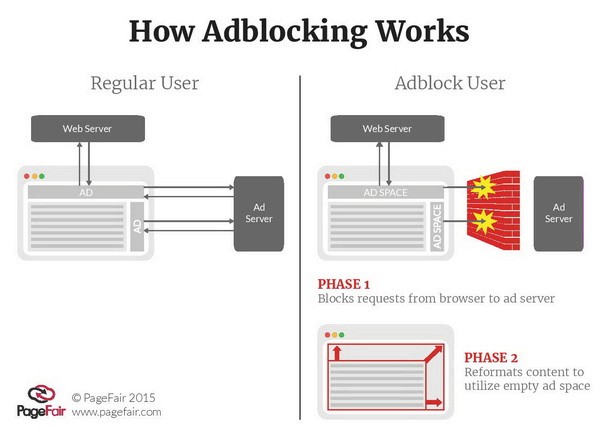Adblock and Anti-adblock – A Game of Chasing and Catching
Mục Lục
For those who work on digital marketing like us, seeing the banner ads on the website when surfing is absolutely normal. We also understand that advertising is sometimes necessary to keep the existence of the website and many companies and brands depend on them to find customers. For marketers, banner ads are an essential part of the ecosystem and we believe that if a product is advertised to the right people at the right time, it will still be beneficial to the user.
However, not everyone thinks so and the fact is that most people do not like advertisements. If you can choose between seeing ads and not seeing them, they will be willing to choose the later option. That’s why adblock apps are becoming increasingly popular. However good your advertising campaign is, it’s useless if it can’t reach users. A world in which all ads are blocked is scary for marketers, but that prospect is actually coming true.
- Adblock blocks banner and text ad
- Adblock blocks flash and video ads
- Adblock even block Facebook ads
What is Adblock?
Before getting to know how adblock works, you need to understand how ad types work. All of the ad formats we see, whether it’s banner, video, flash, or text, are stored on ad servers, and every time a website is loaded, the ad codes on the website send requests to the ad servers. And then the ads are downloaded from the ad server and displayed on the website.
Adblock applications, such as Adblock Plus, uBlock, and so on, are actually browser extensions that can block HTTP and HTTPS requests from the ad servers, as well as prevent iframes, scripts, and Flash from being loaded on the browser. These applications can also automatically hide the text-format ads on the content of the site instead of blocking them. These adblocks work both on the computer browsers and on the mobile browsers, however the mobile version is not as stable and dependent on whether the device is rooted or not.

Source: PageFair
According to Clarity Ray’s report:
– An average of 9% of total impressions are blocked, for some sites this rate is up to 50%.
– Technology websites have the highest average blocking rate (17.97%), followed by news (15.58%) and cultural sites (9.94%). Financial, real estate and tourism websites have lower rate.
– Firefox users have the highest adblock using rate (17.81%), followed by Safari (11.30%) and Chrome (10.06%). IE only has a 3.86% rate.
– Up to 29.03% Linux users use adblock, while only 12.95% Mac users and 9.25% Window users have it.
– Adblock on mobile devices is growing fast with a number of 2.24% for Android nd 1.33% for iOS.
PageFair and Adobe also have a report on this issue, stating:
– In 2015, adblock apps made publishers lose about $ 22 billion in advertising budget.
– Currently there are about 198 million users of adblock applications.
– The number of adblock users has increased by 41% within 12 months.
Another report from Comscore which is quite worrying to see shows that most adblock users are young and have money, who are potential customers for many brands and services.
Obviously we can see adblock as a trend becoming mainstream. As advertisers, it is time for us to pay more attention to the rising of this trend because every user who uses adblock is a user we can not reach with the display advertising method.
When the publishers resist
Ablock means the ad will be blocked -> web users will not be able to see ads -> revenue from advertising will be reduced for that website. This is not good for websites that rely heavily on advertising revenue. And the above numbers is making the website managers more worried than ever.
Some publishers and websites have responded to this situation by using a number of methods to identify adblock users for an appropriate solution. How to detect adblock users? You can find out more here or here. If you use WordPress, you can try this plugin.

Once the adblock user is discovered, then publishers have three options:
- Doing nothing: accept that some users will not like advertising therefore we should not force them to see it. And even though they may not create value for advertising, they can interact and share content on the page that can bring in more traffic.
- Encouraging users to put your website in the whitelist: People who use adblock will see a popup / notice in which they will be explained that the site needs to advertise to survive and asks them to put the website in the whitelist or turn off adblock when accessing. Users can choose to turn off or keep the adblock and continue accessing the site normally.
- Forcing users to turn off the adblock to read the content: this method is more aggressive by forcing the user to turn off the adblock to read the content on the website.
What solution would you choose?
Then the anti-adblock joins the game
With the development to be mainstream of adblock, the advent of anti-adblock is no strange. Recently, AdSupply, a SSP service (Supply Side Platform which supports publishers) has licensed a technology that allows them to pass filters of adblock applications.

The adblock technology works by intercepting requests to the advertising domain. The anti-adblock works on the rule that a proxy domain is used to encrypt the ad server’s concealment and after overcoming the adblock, it will decode and continue to execute the request to display the ad. The entire process is done in real time, with no significant delays in ad exposure, and is estimated to provide 75% – 100% of the number of ads displayed to the users even if they have the adblock installed.
Adblock & anti-adblock: a chasing and catching game with no stops
With publishers and anti-ad blocking apps evolving their methods of preventing, adblock apps do not standstill and continually keep up with many updates of blocking. With publishers, adblock apps keep updating to minimize detection. With anti-adblock apps, they will continually update the proxy domain for inclusion in the block list and prevent ads from overcoming the filter.

source: Getty Image
This is an uncompromising battle between adblock supporters (claiming that users have the power to decide whether they want to see the ad) and anti-adblock-ers (supposing that advertising is needed and ads blocking is making trouble for publishers. Whoever wins in this war is still a mystery and it needs time to know. You may feel that this is no difference from the war between Google and the SEO-ers, where the two sides constantly update so that the other can not take advantage. And neither side is right or wrong, they tend to coexist and fight each other. However, from the writer’s point of view, there is a fundamental problem that we need to look at ourselves.
Adblock is a warning for advertisers
Everything has its causes, why do adblock apps reappear? Is it because users have been bothered by annoying ads? The answer is yes. You’ve probably been interrupted while surfing a website and then suddenly a big advertisement with the size of half the screen pops up and covers what you need to see, or suddenly an autoplay advertisement appears and startle you with sounds or advertisements flying back and forth on the website that you can not turn off? These are just some examples of types of ads that make you only want to boycott the brands appearing on those ads. That is not to mention a bunch of things that are not the fault of advertising but will still be responsible for such as when your computer is infected with malware / adware then you surf the website, you are spammed by series of ads on the browser. That the ads are crammed into the user’s browser is because they may inadvertently install some softwares that contain adware, which is totally not the fault of the ad but thereby the ad will be hated too.
Today’s ads are probably better than what they used to be. Thanks to the development of technology, advertisements are able to reach the right people, the right audience, and the user experience is slowly getting more care from advertisers. However, this does not mean that the annoying types of ads mentioned above will disappear, but that they still exist, and that it take only one time for the users being annoyed to make them use the adblock apps.

source: freepik
We are making our potential customers who we want to reach more upset and never want to see our ads. Obviously there is something wrong going on in the process of advertising among us these days. And we must acknowledge the fact that we ourselves, the marketers, are the main contributors to the increasing use of adblock. Adblock is not just a trend, it is also a WARNING to all marketers that users are not numbers, data that you can stuff with whatever you want them to see. There will come the time they react and that’s it now.
What do you think about this topic? Leave a comment below.







 Vietnamese
Vietnamese English
English